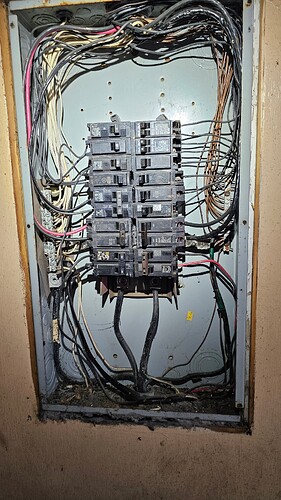Just looked at a home built in 1958- has a new(er) service panel outside, but the distribution panel inside is old - appears to be Murray brand. I’m concerned that of the 20 breakers inside, there are so many different brands of breakers installed - Murray, Siemens, Gould, GE, Challenger, Cutler-Hammer, and a Square D thrown in. The panel looks old enough to be original, but not sure if Murray was around in 1958.
Now this house suffered a house fire in 2000, and I’m sure this panel pre-dates THAT.even though there was a permit to “re-wire burnt out house” in 2000.
Is there a question?
If anyone can tell me if Murray panels were around in 1958? I’m filling out a 4Point report for their insurance, and they insist that I try to determine the age of the panel.
Murray was there in 1958.
I think types of Square D & Siemens were compatible.
Perhaps just note on the 4 point electrical rehab with the permit as proof.
Depends on what the underwriter was smoking that day if it will fly.
I doubt an underwriter will pay that much attention. Separately, I’m going to recommend they get an electrician out to go over the panel. Supposedly, Siemens says their breakers are good in panels made after 2002, but Gould? or Challenger? These are good customers - I’ve done 4 points on 4-5 of their rental properties and they always follow up when I make a recommendation.
That panel doesn’t look like it’s from 1958, but you have a permit that suggests a date after the fire.
Dominic - I didn’t think so either, but it’s not from 2000, when the house was re-wired either…
Without the back story, I would have guessed a mid '80’s upgrade by the look of it.
That may be good - current owners purchased it in 1983!
OK. You tried. Now, note on the report that you were not able to determine how old it is. Don’t let an insurance person, who very likely knows a lot less than you do, lead you down a rabbit hole.
I agree - This is more effort than I usually put into that determination. But I rarely see a Murray panel, and wanted to try to educate myself. My bigger concern was the myriad of different brands of breakers. Often, I see those ill-fitted or loose. But this was not bad.
Evening, Andrew.
Murry electrical, a old company specializing in distribution and protection devices has a history marked by acquisition and brand changes prior 1900.
Murray Electrical was Founded in 1899, later purchased by Arrow Hart Co, now owned by Eaton.
The brand was subsequently acquired by Crouse Hinds Company (Copper Industries) before the end of the 1970s, but the Murray name was dropped after a few years.
The Murray brand was resurrected in the 1990s when Siemens purchased the line from Crouse-Hinds. Today, Murray is a sub-brand of Siemens, with components often being interchangeable.
Murry is a defunct manufacturer of electrical distribution equipment.
Wanting to educate yourself is a good thing, but for purposes of a Four-Point you are expected to identify hazards or the specific conditions that are on the Four-Point report.
Manufacturers always recommend using their breakers exclusively. At the same time, many breakers are intentionally designed to be physically interchangeable with many other brands.
The fact that there are breakers from different manufacturers doesn’t mean that they create a hazard.
Very few fires start in electrical panels, and of those that do rarely extend beyond the panel box. Fires can start elsewhere in a house as a result of a problem in a panel but ill fitting breakers are not going to cause a fire.
If something you see isn’t specifically listed on the Four-Point and you can’t clearly articulate a specific hazard, it doesn’t need to go into the report.
I would not list mismatched breakers because they don’t constitute a hazard. If someone were to ever challenge you for not listing them as a hazard, I suggest asking what the specific hazard is. If they give you a generic “Fire hazard” answer, ask them to explain exactly how that would happen.
Murray panels are OK. I’ve installed and serviced a lot Murray panels. They are no better or worse than most other panel brands. They are just plain white bread panels.
